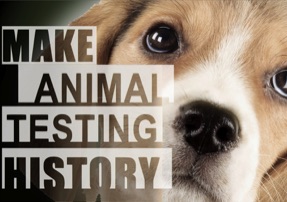Follow Us
Vivisection: Historic and Legal Context

We have written a historic and legal summary to help shed light on where science was when animal experiments first became institutionalized, in 1847, and where science is now.
Historical Perspective
Experiments on animals, claimed as able to 'predict' human responses for human medicine, first became institutionalised in 1847 through a French physician Claude Bernard. This quickly grew to become the mainstay for twentieth century bio-medical research, despite its 130 year old, comparatively antiquated origin.
Where was science during this time, in the 19th century?
To gain an insight into where science was during this period in the 19th century, when Bernard first institutionalized animal experiments, an excerpt from the following paper sheds clear light:
'Claude Bernard, the father of scientific physiology, believed that if medicine was to become truly scientific, it would have to be based on rigorous and controlled animal experiments. Bernard instituted a paradigm which has shaped physiological practice for most of the twentieth century. In this paper we examine how Bernard's commitment to hypothetico-deductivism and determinism led to a) his rejection of the theory of evolution; b) his minimalization of the role of clinical medicine and epidemiological studies; and c) his conclusion that experiments on non-human animals were "entirely conclusive for the toxicology and hygiene of man". We examine some negative consequences of Bernardianism for twentieth century medicine, and argue that physiology's continued adherence to Bernardianism has caused it to diverge from the other biological sciences which have become increasingly infused with evolutionary theory'. (Emphasis added). Please visit this link for the full paper.
In 1938, the US Federal Food, Drug and Cosmetic Act first required some animal testing by law, and this became yet further enshrined in the 1946 Nuremberg Code, when scientific understanding was still, comparatively speaking, in its infancy. An important legal and scientific paper expounds relevant international scientific evidence to date, and places this within a legal and historical perspective. This impressive report is ideal for witness testimony at any public hearing or legal challenge:
The Nuremberg Code subverts human health and safety by requiring animal modeling.
When did animal experiments first become a requirement by law?
Where was science during this time, when animal experments first became a legal requirment?
To understand where science was when this Nuremberg Code was established, and animal testing first became a requirement by law, the following excerpt from the above paper sheds a clear light (all references are at the bottom of this page):
"At the time of the Nuremberg trials, medical science was very different than it is now. The structure of DNA had not been elucidated, scientists thought the poliovirus entered via the nose (it enters through the gut) [27], the notion of a magic bullet (that for every disease, or at least every infectious disease, a chemical existed that could interact with the single site causing the malady and thus cure the disease without harming the rest of the body) via Ehrlich and Salvarsan [28] was foremost in the minds of drug developers, the modern synthesis in evolution was brand new [29], and animals and humans seemed to be more or less the same except for humans having a soul [2,30,31]. There were no organ transplants, infectious diseases were still a major killer in the developed world, the fields of cognitive ethology and animal cognition were unheard of, and differences between ethnic groups [32-38] and sexes [39-43] in terms of disease and drug reactions had not yet been discovered. Physics was just beginning to cast off the shackles of determinism and reductionism but chaos and complexity theory was still on the horizon. It was a different world. People in the 1940s are to be excused for thinking that animals and humans would react more or less the same to drugs and disease. We will now bring the reader into the current scientific environment as it relates to our topic [30,44-49]. For the full article please click here
History shows that science often progresses through the enlightened work of individuals, such as Darwin who brought us the Theory of Evolution, Einstein who gave us the Theory of Relativity and Jenner, Lister and Semmelweis who all contributed to the Germ Theory of Disease. Science has recently named Trans-Species Modeling Theory, (TSMT) which is the theory that explains the many decades of practical evidence against using animal experiments to 'predict' human responses [50].TSMT takes its place alongside other great scientific theories which likewise enrich our life on earth by explaining many years of observed, practical evidence.
We highlight the fact that pharmaceutical companies acknowledge the failure of animal models in their drug development process and write about this openly and often in the scientific literature. Please visit this link for extensive examples.
27. Paul JR: A History of Poliomyelitis. New Haven: Yale University Press; 1971.
28. Ehrlich P, Hata S: Die experimentalle Chemotherapie der Spirillosen. Berlin: Springer; 1910.
29. Mayr E: What evolution Is. Basic Books 2002.
2. Elliot P: Vivisection in Historical Perspective. edn. In Vivisection and the Emergence of Experimental Medicine in Nineteenth Century France. Edited by Rupke N. New York: Croom Helm; 1987:48-77.
30. LaFollette H, Shanks N: Animal Experimentation: The Legacy of Claude Bernard. Int Stud Philos Sci 1994, 8(3):195-210.
31. Bernard C: An Introduction to the Study of Experimental Medicine. New York: Dover; 1957 (1865).
32. Cheung DS, Warman ML, Mulliken JB: Hemangioma in twins. Ann Plast Surg 1997, 38(3):269-274.
33. Couzin J: Cancer research. Probing the roots of race and cancer. Science 2007, 315(5812):592-594.
34. Gregor Z, Joffe L: Senile macular changes in the black African. Br J Ophthalmol 1978, 62(8):547-550.
35. Haiman CA, Stram DO, Wilkens LR, Pike MC, Kolonel LN, Henderson BE, Le Marchand L: Ethnic and racial differences in the smoking-related risk of lung cancer. N Engl J Med 2006, 354(4):333-342
36. Spielman RS, Bastone LA, Burdick JT, Morley M, Ewens WJ, Cheung VG: Common genetic variants account for differences in gene expression among ethnic groups. Nat Genet 2007, 39(2):226-231.
37. Stamer UM, Stuber F: The pharmacogenetics of analgesia. Expert Opin Pharmacother 2007, 8(14):22352245.-
38. Wilke RA, Dolan ME: Genetics and Variable Drug Response. JAMA: The Journal of the American Medical Association 2011, 306(3):306-307.
39. Holden C: Sex and the suffering brain. Science 2005, 308(5728):1574.
40. Kaiser J: Gender in the pharmacy: does it matter? Science 2005, 308(5728):1572.
41. Simon V: Wanted: women in clinical trials. Science 2005, 308(5728):1517.
42. Wald C, Wu C: Of Mice and Women: The Bias in Animal Models. Science 2010, 327(5973):1571-1572.
43. Willyard C: HIV gender clues emerge. Nat Med 2009, 15(8):830.
44. LaFollette H, Shanks N: Animal models in biomedical research: some epistemological worries. Public Aff Q 1993, 7(2):113-130.
45. LaFollette H, Shanks N: Brute Science: Dilemmas of animal experimentation. London and New York: Routledge; 1996.
46. Shanks N, Greek R: Animal Models in Light of Evolution. Boca Raton: Brown Walker;2009.
47. Shanks N, Greek R, Greek J: Are animal models predictive for humans? Philos Ethics Humanit Med 2009, 4(1):2.
48. Greek R, Greek J: Is the use of sentient animals in basic research justifiable? Philos Ethics Humanit Med 2010, 5:14.
49. Greek R, Shanks N, Rice MJ: The History and Implications of Testing Thalidomide on Animals. The Journal of Philosophy, Science & Law 2011, 11.
50. Greek, R. and L.A. Hansen, Questions regarding the predictive value of one evolved complex adaptive system for a second: exemplified by the SOD1 mouse Progress in Biophysics and Molecular Biology, 2013: p. http://dx.doi.org/10.1016/j.pbiomolbio.2013.06.002. http://www.sciencedirect.com/science/article/pii/S0079610713000539
Where is Science Now, in 2014?
Pharmaceutical companies openly acknowledge the failure of animal models
This Page
Latest Tweets
